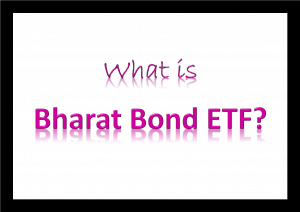Bharat bond ETF is a debt exchange-traded fund (ETF) that will hold bonds issued by PSEs owned by the Government of India.
What is unique about Bharat Bond?
Bharat Bond ETF is the first corporate bond ETF in the country going to be traded in the stock exchanges. It is a brand-new investment product for the investors as well.
| What is an exchange traded fund?
An ETF is a basket of securities that are traded on a stock exchange. It is traded just like shares in the stock market. ETFs are listed on a recognized exchange and their units can be bought and sold directly on the exchange through a stockbroker during the trading hours. The conventional mutual funds don’t have this tradability in the stock exchange. We can say that ETF is like a mutual fund that one can buy and sell in real time (in the stock exchange), at a price that keeps changing throughout the day. An ETF holds assets such as stocks (shares), bonds, or commodities and trades over the course of the trading day. |
It is a pure Debt Fund. Its equity counterpart is Bharat 22 Fund. The government has launched Bharat 22 Fund that contained the stocks of companies few years back. So, if Bharat 22 was an equity fund, Bharat Bond is a debt fund.
Where does the Bond ETF invest?
The Bharat Bond ETF invests in AAA rated bonds of PSEs such as REC, PFC, NHAI, etc.
What is the minimum and maximum amount of investment?
The minimum amount is Rs 1,000 per bond and there is no maximum limit. But for retail investors, there is an upper limit of Rs 2 Lakhs.
What are the advantages of Bharat Bond for investors?
The Bharat Bond ETF offers a unique combination of assured return (if held to maturity), beneficial tax treatment (if held for more than three years) and liquidity (if one needs to exit before maturity – as the ETFs will be listed on the exchanges).
Backgrounder on the launch of Bharat Bond
In the 2019 budget, the government indicated the creation of a dedicated debt EFT for PSEs. Objective of the step as per the government is to provide mor liquidity options to PSEs and to give an investment option for the general public.
The Cabinet Committee on Economic Affairs (CCEA), chaired by PM Narendra Modi earlier approved (on December 4, 2019) the creation of Bharat Bond Exchange Traded Fund (ETF).
Bharat Bond ETF was launched on December 12th 2019 and closed on 20th of the same month. The ETF was subscribed 12 times and became a big success.
What is the maturity of the bonds under Bharat Bond?
The Bharat Bond holds two types of bonds. First is the 3+ years that is the April 2023 variant which would mature in April 2023 (3+ years) and second, the 10+ years ETF bond that is the April 3030 variant which would mature in April 2030 (10+ years).
What are the advantages and objectives of the Bharat Bond ETF launch?
| Objectives of Bharat Bond ETF
The government floated this debt ETF with the following objectives: (a) The bond ETF will help deepen the Indian debt markets; at the same time providing opportunity for participation of retail investors. (b) Additionally, it will help the underlying PSE companies to raise funding for their operations. |
The ETF will help public-sector companies raise funds through debt instruments. Besides, it will help to develop the domestic capital markets market further. It is expected to boost alternative sources of funding for firms at a time when banks and NBFCs are reluctant to give funds to the corporate sector.
The ETF will also increase the participation of retail investors as they are currently not participating in bond markets due to liquidity and accessibility constraints. Here, in this ETF, retail investors can directly subscribe (accessibility) the ETF and they can sell it in the stock market (liquidity). Overall, the ETF is expected to develop a new ecosystem of players as it is a novel product.
*********










